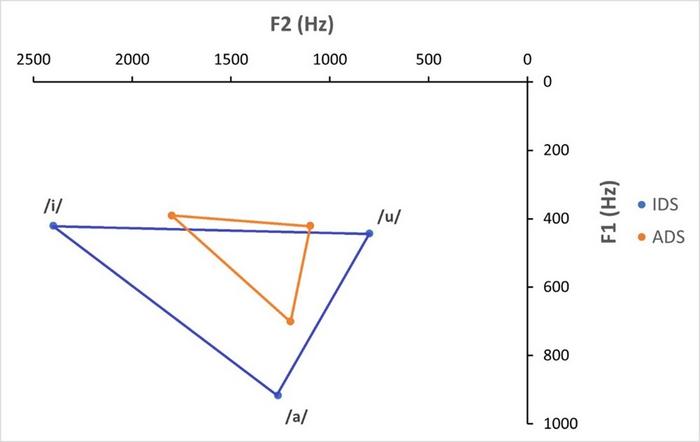In a groundbreaking meta-analytic review published recently in Psychological Bulletin, an international team of scientists has shed new light on a longstanding debate in linguistics and developmental psychology: Do adults genuinely exaggerate vowel sounds when speaking to infants? This phenomenon, known as vowel hyperarticulation in infant-directed speech (IDS), has been widely suspected but inconsistently documented across languages and studies. The comprehensive analysis led by researchers from the International Research Center for Neurointelligence (WPI-IRCN) at The University of Tokyo, alongside collaborators from the University of Amsterdam, PSL University, and Aarhus University, definitively confirms the presence of acoustic exaggeration of vowels in speech directed toward babies.
Infant-directed speech differs in many ways from the typical adult-directed speech (ADS), including pitch, intonation, and lexical choices. However, one complex aspect that has puzzled scientists involves whether vowels—essential building blocks of language—are deliberately pronounced with enhanced clarity or exaggeration to facilitate infant language acquisition. The first and second formants (F1 and F2), which correspond to tongue height and front-back position in vowel articulation, serve as critical acoustic markers in studying this phenomenon. Previous research has yielded conflicting results, with some studies asserting clear evidence of exaggerated vowels, while others found no significant effects, leading to enduring controversy.
To resolve these contradictions, the researchers undertook meta-analyses involving 20 studies that specifically investigated vowel hyperarticulation in IDS with comparable methodologies, alongside a broader analysis of 35 studies employing a diverse array of research techniques. By pooling data and enhancing statistical power, meta-analytic techniques allowed the team to uncover overarching patterns invisible to smaller, isolated studies. The results revealed a consistent effect: across at least ten languages, caregivers tend to hyperarticulate vowels such as /a/, /i/, and /u/ when interacting with infants. This exaggerated vowel space, visualized as larger triangles in the acoustic plane defined by F1 and F2, suggests that caregivers modify their speech to produce clearer, more distinct vowel sounds.
The significance of vowel exaggeration lies in its presumed role in facilitating language learning during a sensitive developmental window. Infant-directed speech has long been recognized for its unique ability to capture babies’ attention and support phonetic discrimination, but these findings reinforce the idea that acoustic clarity plays a pivotal role. By expanding the vowel space, caregivers may be providing infants with amplified acoustic cues that highlight the boundaries between different vowel categories, thereby easing the cognitive load required for speech perception and word segmentation.
Despite confirming the existence of vowel hyperarticulation in IDS, the authors emphasize substantial methodological diversity among the analyzed studies. Variations in data collection, analysis techniques, and acoustic measurement scales—such as Hertz versus Mel frequencies—affect the comparability of results and the magnitude of observed effects. Furthermore, much of the literature suffers from limited sample sizes, which constrain statistical robustness and reduce confidence in language-specific findings. The authors call for larger, methodologically rigorous studies to explore cross-linguistic and cross-cultural variability more definitively.
Notably, the meta-analysis also acknowledges that some earlier conflicting findings may stem from extraneous variables like caregivers’ facial expressions, including smiling, which could indirectly affect speech production without intentional vowel exaggeration. Distinguishing between deliberate hyperarticulation and inadvertent speech changes due to affective states remains a fertile area for future inquiry. The researchers advocate for more detailed and standardized experimental designs incorporating both acoustic and behavioral dimensions to unpack these complex interactions.
Looking ahead, the study’s lead author, Dr. Irena Lovčević, underscores the broader implications for understanding infant language development beyond vowel hyperarticulation. She points to modifiable environmental factors influencing infants’ linguistic capacities, such as the quantity and quality of caregiver speech exposure and interactive vocal engagements. These factors could interact with acoustic exaggeration to optimize developmental trajectories and support early communication skills. Unlocking these mechanisms holds promise for addressing speech and language delays and enhancing early childhood education strategies.
The interdisciplinary nature of this research—melding neuroscience, linguistics, and cognitive science—highlights the dynamic, multifaceted process of human speech acquisition. The International Research Center for Neurointelligence employs cutting-edge techniques to probe neural circuit maturation and psychiatric disorders affecting language functions, which complements behavioral and acoustic insights into IDS. By advancing rigorous meta-analytic frameworks, this work bridges empirical gaps and propels the global scientific community toward a unified understanding of how humans master language so effortlessly during infancy.
This comprehensive meta-analysis has been supported by prestigious grants including Japan’s MEXT World Premier International Research Center Initiative and JSPS KAKENHI, reflecting the international significance of uncovering universal and language-specific features of infant-directed speech. The collaborative efforts span institutions across Japan, the Netherlands, France, and Denmark, underscoring the global scope necessary to tackle fundamental questions about human communication.
As the scientific community digests these findings, future research will be tasked with refining acoustic measurement paradigms, expanding participant diversity, and integrating neurodevelopmental perspectives. By doing so, researchers hope to unravel the “big puzzle” of effortless infant language acquisition, from the acoustic properties of caregiver speech to the underlying neural computations shaping early cognitive development. This study marks a critical step toward that goal, confirming that exaggerated vowel articulation is indeed a tangible feature of baby talk and a potential cornerstone in the architecture of early language learning.
Subject of Research: People
Article Title: Acoustic Exaggeration of Vowels in Infant-Directed Speech: A Multi- Method Meta-Analytic Review
News Publication Date: 2-Jun-2025
Web References:
DOI: 10.1037/bul0000479
Image Credits:
Irena Lovčević, International Research Center for Neurointelligence (WPI-IRCN), The University of Tokyo
Keywords:
Linguistics




